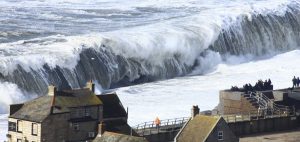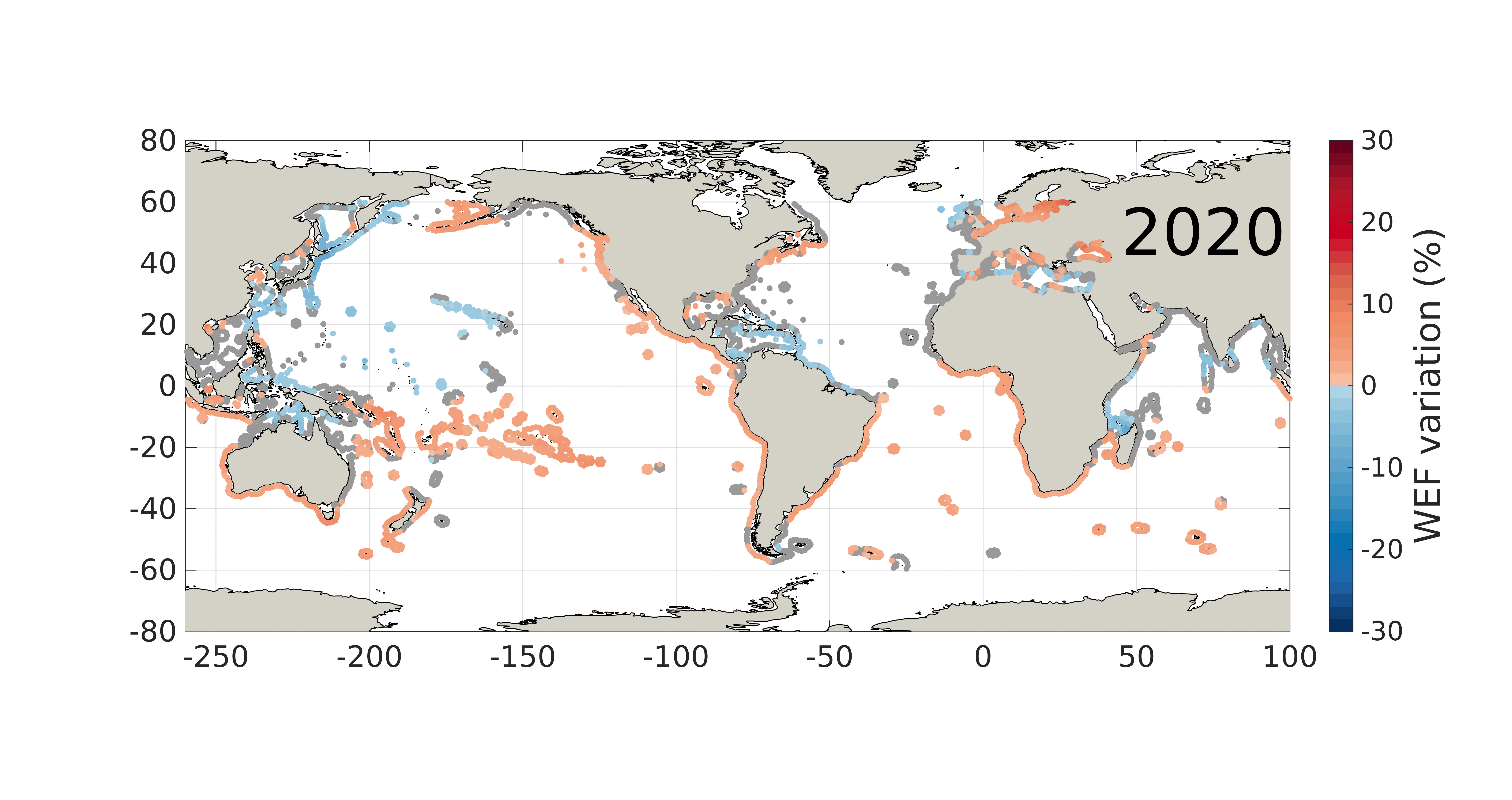14 March 2017
WASHINGTON, DC — Massive coastal flooding in northern Europe that now occurs once every century could happen every year if greenhouse gas emissions continue to rise, according to a new study.
New projections considering changes in sea level rise, tides, waves and storm surge over the 21st century find global warming could cause extreme sea levels to increase significantly along Europe’s coasts by 2100. Extreme sea levels are the maximum levels of the sea that occur during a major storm and produce massive flooding.
The increase in frequency of these events that are today considered exceptional will likely push existing coastal protection structures beyond their design limits, leaving a large part of Europe’s coastal zones exposed to flooding, according to the study’s authors.
“Unless we take different protection measures, 5 million people will be exposed to coastal flooding on an annual basis,” said Michalis Vousdoukas, a coastal oceanographer at the Joint Research Centre (JRC) of the European Commission and the lead author of the new study published in Earth’s Future, a journal of the American Geophysical Union.

Extreme waves crashing on Chesil Beach in Dorset in southern England on February 5, 2014. A new study finds find global warming could cause extreme sea levels to increase significantly along Europe’s coasts by 2100.
Image credit: Richard Broome.
Northern Europe will see the strongest increase in extreme sea levels. Areas along the Mediterranean and the Black Sea could see these 100-year extreme sea level events several times a year. In the North Sea region, extreme sea levels could increase by nearly 1 meter (3 feet) under the worst-case scenario. The Atlantic coasts of the United Kingdom and Ireland could see similar increases in extreme sea levels, while lower but still considerable increases in extreme sea levels are projected for the Norwegian and Baltic seas.
Information about the number of people at risk from flooding can be used to determine how large the social and economic impact of these events will be, said Marta Marcos, a researcher at the Mediterranean Institute for Advanced Studies in Spain, who was not involved in the new study.
“In terms of adaptation strategies and policymaking, it is very relevant,” she said.
Considering all components
The new research considers how all components that can influence extreme sea levels, including the mean sea level, tides, waves and storm surge, will be affected by climate change. The researchers used information about these different components to project changes in extreme sea levels by 2100 under different greenhouse gas scenarios. Using all of these components provides a more accurate projection of how extreme sea levels will change this century, according to the study’s authors.
Under the most extreme scenario, where greenhouse gas emissions continue to rise throughout this century, extreme sea levels along Europe’s coastlines could increase by 81 centimeters, or more than 2 ½ feet, on average, by 2100. That means 5 million Europeans who are currently under threat of flooding from extreme sea level events that occur every 100 years could face that same risk annually, according to the new study.
Even under a more moderate scenario where greenhouse gas emissions peak in 2040, 100-year extreme sea levels could increase by 57 centimeters, or nearly 2 feet, on average, by the end of the century, with these events occurring every few years, according to study’s authors.

This gif shows changes in wave energy flux on global scale over the time. Blue indicates a decrease in wave energy flux. Red indicates an increase in wave energy flux.
Credit: Lorenzo Mentaschi
The changes in one of these components, wave energy flux, is detailed in a new study in Geophysical Research Letters, a journal of the American Geophysical Union. That study finds that if greenhouse gas emissions continue to rise, the energy waves carry to the coast will change significantly around the world by the end of the century.
In the southern hemisphere, extreme waves could carry up to 30 percent more energy by 2100, according to the new study. This means stronger waves will become more frequent, and have a greater impact on the coast, said Lorenzo Mentaschi, also at the JRC and lead author of the GRL study. The new GRL study attributes the changes in wave energy to the intensification of weather patterns, like the Antarctic Oscillation, El-Nino Southern Oscillation and the North Atlantic Oscillation.
The new research will be provided to EU policymakers. The data will also be made public so it can be used by scientists, engineers and coastal managers.
The research leading to these results has received funding from the European Union Seventh Framework Programme FP7/2007-2013 under grant agreement no. 603864 (HELIX: “High-End cLimate Impacts and eXtremes”; www.helixclimate.eu).”
###
The American Geophysical Union is dedicated to advancing the Earth and space sciences for the benefit of humanity through its scholarly publications, conferences, and outreach programs. AGU is a not-for-profit, professional, scientific organization representing 60,000 members in 137 countries. Join the conversation on Facebook, Twitter, YouTube, and our other social media channels.
Notes for Journalists
The Earth’s Future research article is open access. A PDF copy of the article can be downloaded at the following link: http://onlinelibrary.wiley.com/doi/10.1002/2016EF000505/abstract
The Geophysical Research Letters research article is open access. A PDF copy of the article can be downloaded at the following link: http://onlinelibrary.wiley.com/doi/10.1002/2016GL072488/abstract
Journalists and PIOs may also order a copy of the final papers by emailing a request to Nanci Bompey at [email protected]. Please provide your name, the name of your publication, and your phone number.
Neither these papers nor this press release is under embargo.
Title:
“Extreme sea levels on the rise along Europe’s coasts” (Earth’s Future)
Authors:
Michalis I. Vousdoukas: European Commission, Joint European Research Centre (JRC), Ispra, Italy; and Department of Marine Sciences, University of the Aegean, Lesbos, Greece;
Lorenzo Mentaschi: European Commission, Joint European Research Centre (JRC), Ispra, Italy;
Evangelos Voukouvalas: European Commission, Joint European Research Centre (JRC), Ispra, Italy;
Martin Verlaan: Deltares, Delft, The Netherlands.
Luc Feyen: European Commission, Joint European Research Centre (JRC), Ispra, Italy.
Title:
“Global changes of extreme coastal wave energy fluxes triggered by intensified teleconnection patterns” (Geophysical Research Letters)
Authors:
Lorenzo Mentaschi: European Commission, Joint European Research Centre (JRC), Ispra, Italy;
Michalis I. Vousdoukas: European Commission, Joint European Research Centre (JRC), Ispra, Italy; and Department of Marine Sciences, University of the Aegean, Lesbos, Greece;
Evangelos Voukouvalas: European Commission, Joint European Research Centre (JRC), Ispra, Italy;
Alessandro Dosio: European Commission, Joint European Research Centre (JRC), Ispra, Italy;
Luc Feyen: European Commission, Joint European Research Centre (JRC), Ispra, Italy.
Contact information for the authors:
Michalis I. Vousdoukas: +39 033278-6499, [email protected]
Nanci Bompey
(202) 777-7524
[email protected]
JRC Press Contact:
Jolanta Zubrickaite
+39 0332 78 9007
[email protected]